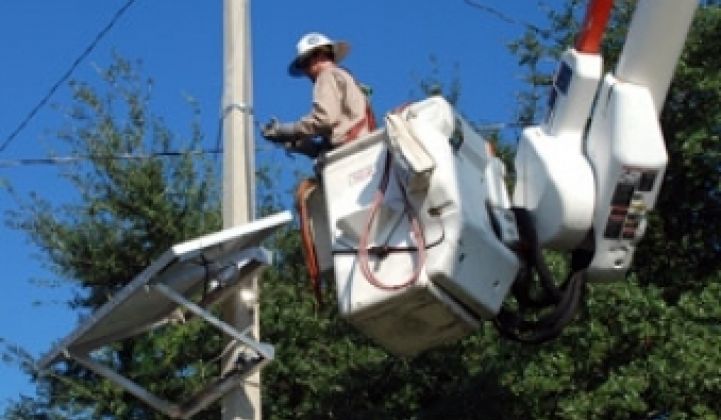The solar cell has gone home.
AT&T, the telecom giant, announced a deal with Petra Solar in which the two companies will join forces promote Petra's novel SunWave solar modules to utilities. The SunWave modules, which also sport smart grid functionality, will communicate to utilities over AT&T's wireless networks.
SunWave modules don't get planted on roofs or in dry plots of land in the desert. Instead, they are attached to telephone and utility poles, but unlike those remote solar panels seen on roadsigns, the power produced does not go into the devices they happen to be attached to at the moment. Instead, the power gets fed into an inverter and then into the grid for general use.
Exploiting the pole down on the need to buy real estate or negotiate easements, it makes connecting the poles to the grid incredibly easy. The panels link into the secondary voltage lines on the pole.
But wait! There's more. Petra has also integrated smart grid intelligence to make power production from the panels integrate more smoothly with the grid. The intermittent nature of solar power, especially as it expands, continues to give regulators and utilities the willies. Earlier this year, PSE&G agreed to install 40 megawatts' worth of SunWave modules on 200,000 poles in New Jersey. (These are some of the reasons we picked Petra as a Top 50 Greentech Media startup.) The functionality in the panels can also be used for general grid monitoring and other functions, according to Joe DeLuca, a vice president at Petra.
The deal marks AT&T's further push into energy. The company already has a deal with SmartSynch under which SmartSynch's smart grid services run over AT&T's cellular networks. It also has a deal with the Current Group for grid services. With Petra, AT&T will now provide efficiency services as well as equipment for producing power. That puts the company in both of the mega-markets in the green industry.
Will AT&T only resell panels to utilities or will it ultimately act as a power provider, selling power to utilities generated by the SunWave panels it owns and maintains itself? Either outcome is possible and it all remains to be seen. Think of it. One day, if you have a blackout, you might be able to call to complain about it on your occasionally functional iPhone and talk to the same company.
AT&T won't be the first carrier to dabble in power or power equipment. In Australia, some carriers already offer the five-way play of cellular, phone, Internet, TV, and utilities. In the U.S., Google has already landed a license to buy and sell power, and competing carriers like Verizon and Comcast have been investing in green companies and beefing up services. Back in 2008, Comcast's move to get into power was considered wacky, but sources say the company has been concocting big plans.
While it is not a major producer of solar cells or modules, AT&T knows solar. Calvin Fuller, Daryl Chapin and Gerald Pearson created the first silicon photovoltaic cell at Bell Labs in 1954. It was only four percent efficient, but Bell raised the figure to 11 percent soon after. Today, the maximum efficiency for silicon PV is around 29 percent with a realistic limit of 25 percent. SunPower will soon be selling commercial cells at 23 percent.



